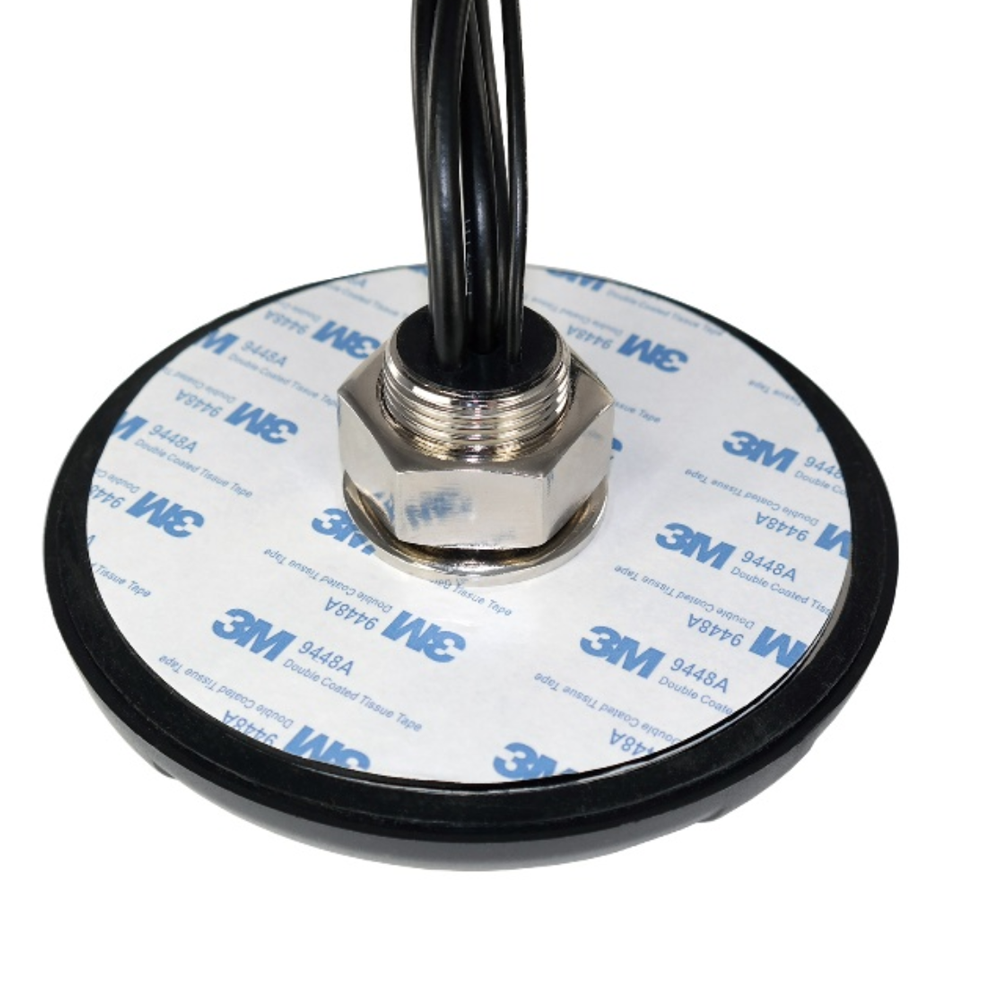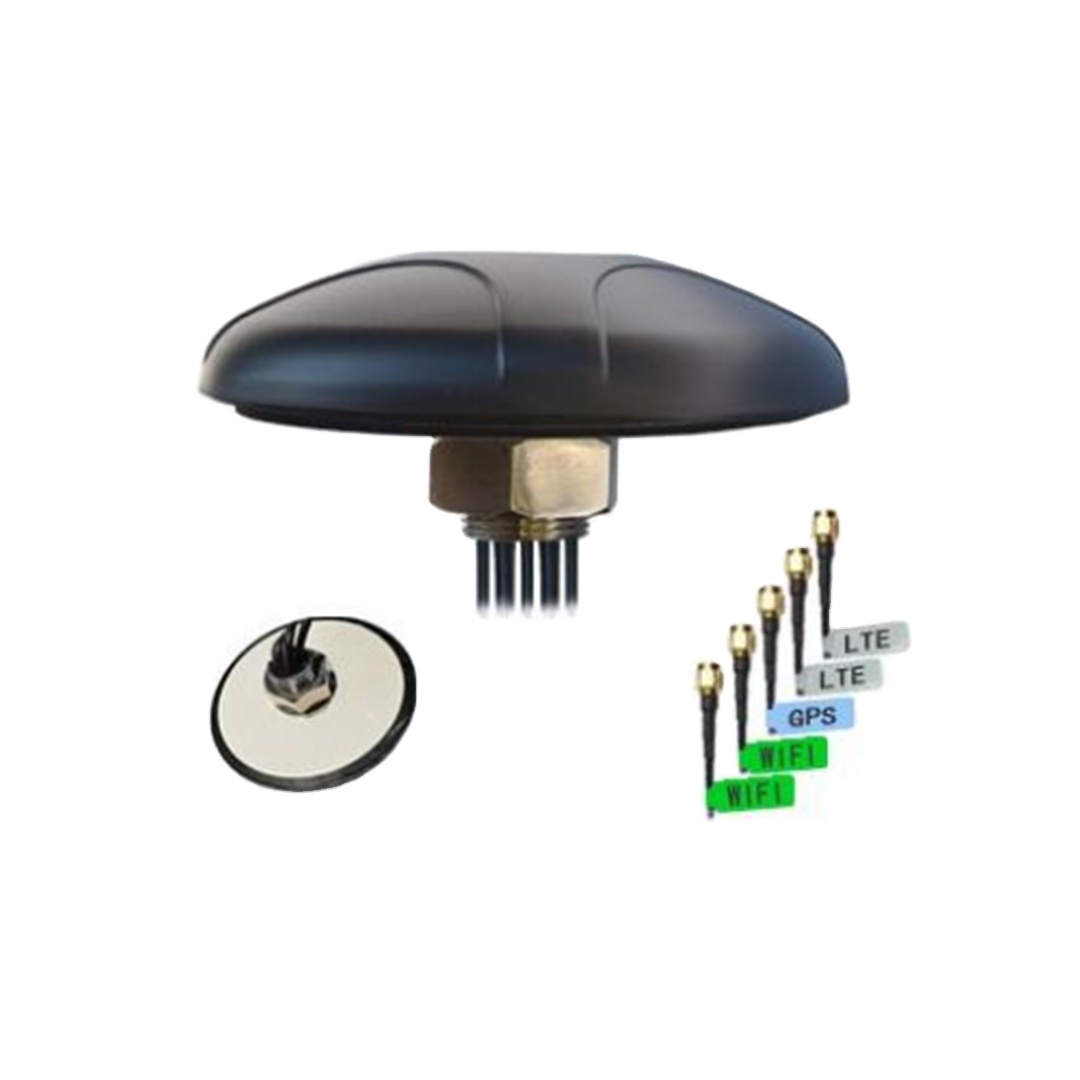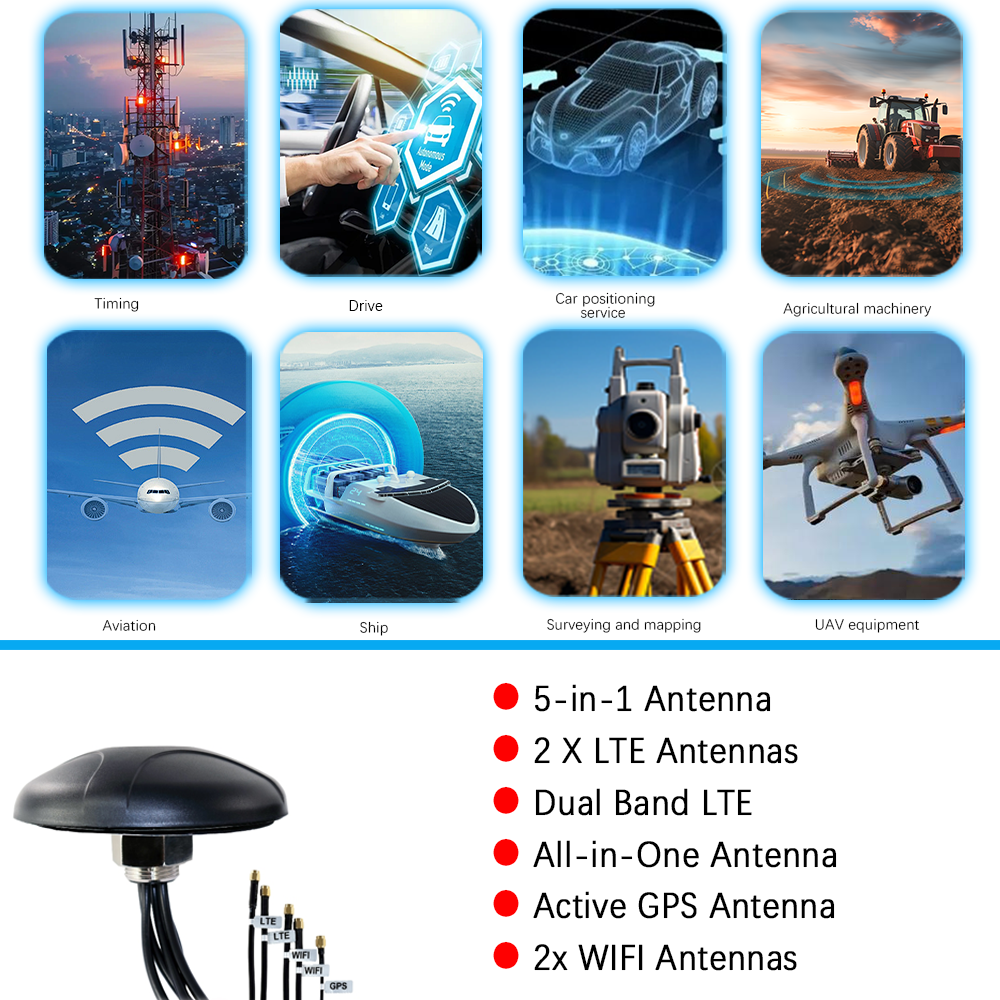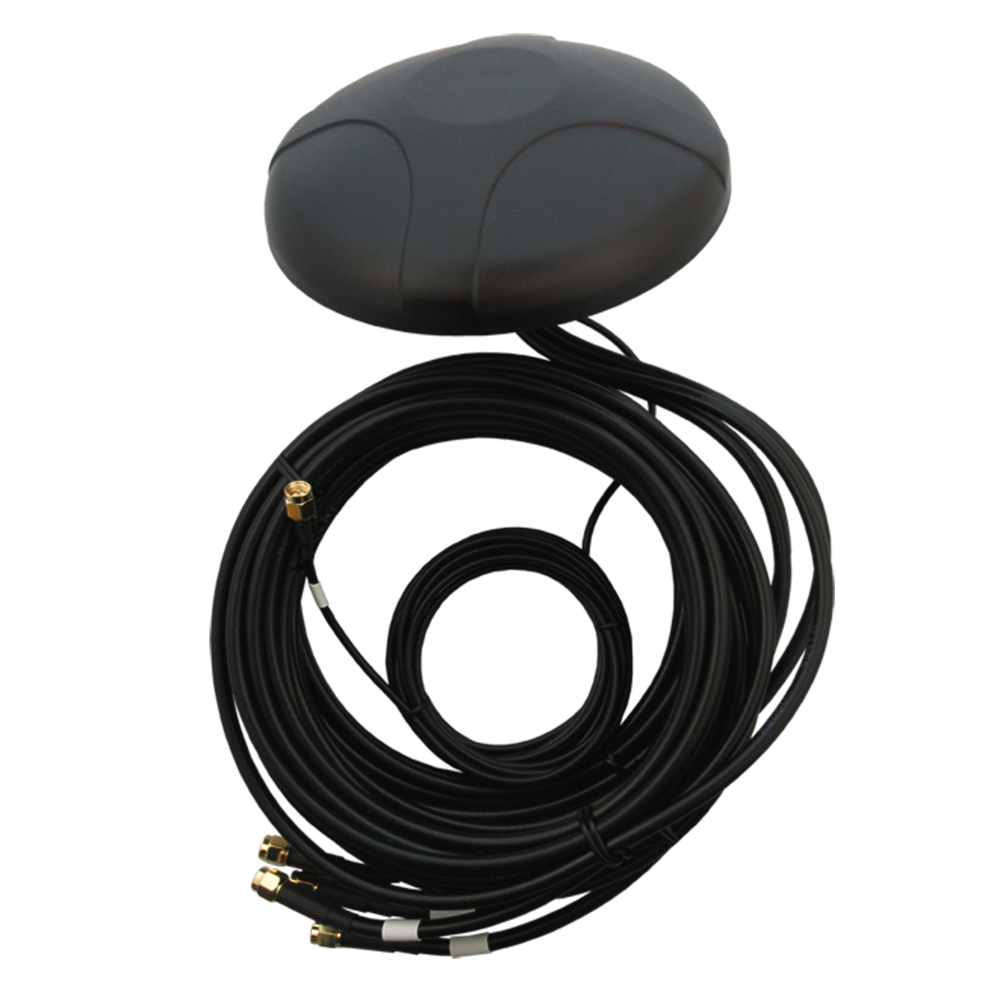5.1. Current Applications
The low - profile mushroom GPS antenna’s unique combination of small size, reliable performance, and cost - effectiveness has made it a staple in a wide range of industries. Below are its key current applications, highlighting how it addresses specific needs in each sector.
5.1.1. Consumer Electronics
Consumer electronics is the largest market for low - profile mushroom GPS antennas, driven by the demand for compact, multi - function devices like smartphones, smartwatches, and handheld navigation devices.
Smartphones: Modern smartphones rely on GPS for location - based services (LBS) such as mapping (Google Maps, Apple Maps), ride - hailing (Uber, Lyft), food delivery, and fitness tracking. The low - profile mushroom antenna is integrated into the phone’s PCB, typically near the top edge or behind the display, to avoid adding to the device’s thickness. For example, Apple’s iPhone uses a low - profile GPS antenna (likely a mushroom or similar microstrip design) to support GPS, GLONASS, Galileo, and BeiDou, enabling accurate location tracking for apps like Apple Fitness+ (which monitors outdoor runs) and Find My iPhone. The antenna’s azimuthal symmetry ensures consistent reception even when the phone is in the user’s pocket or hand, and its cost - effectiveness makes it suitable for high - volume production.
Smartwatches and Wearables: Smartwatches (e.g., Apple Watch, Samsung Galaxy Watch) and other wearables (e.g., fitness trackers like Fitbit Charge) use GPS to track outdoor activities such as running, cycling, and hiking. The ultra - low profile of the mushroom antenna is critical here, as wearables must be lightweight and comfortable to wear. The antenna is often integrated into the watch’s case or strap, with a small PCB serving as the ground plane. For example, the Apple Watch Ultra uses a low - profile GPS antenna to support precision location tracking for outdoor adventures, including backcountry hiking and ocean kayaking. The antenna’s compact size allows it to fit within the watch’s 14.4 mm thick case, while its gain (≈3 dBi) is sufficient to receive GPS signals even in remote areas.
Handheld Navigation Devices: Handheld GPS devices used for hiking, camping, and geocaching also use low - profile mushroom antennas. These devices require reliable GPS reception in outdoor environments but must be compact and lightweight for portability. The mushroom antenna’s low profile allows the device to be slim and easy to carry, while its bandwidth ensures it can receive signals from multiple GNSS systems (GPS, GLONASS, Galileo) for improved accuracy. For example, Garmin’s eTrex series of handheld GPS devices uses a low - profile antenna to support multi - GNSS reception, enabling users to navigate in remote areas with limited satellite visibility.
5.1.2. Automotive Industry
The automotive industry relies on low - profile mushroom GPS antennas for navigation, telematics, and advanced driver - assistance systems (ADAS), where discreet installation and aerodynamic performance are key.
In - Vehicle Navigation: Most modern vehicles come equipped with built - in navigation systems that use GPS to provide turn - by - turn directions. The low - profile mushroom antenna is mounted discreetly inside the vehicle—typically under the roof liner, behind the windshield, or within the rearview mirror—to avoid disrupting the vehicle’s exterior design. For example, Tesla vehicles use a low - profile GPS antenna integrated into the rearview mirror housing to support the car’s navigation system and Autopilot features. The antenna’s low profile ensures it does not affect the vehicle’s aerodynamics, which is critical for maximizing electric vehicle (EV) range.
Telematics and Fleet Management: Fleet operators use GPS - enabled telematics systems to track vehicle location, monitor driver behavior (e.g., speed, idling time), and optimize routes. The low - profile mushroom antenna is ideal for this application because it can be installed quickly and discreetly on any vehicle (cars, trucks, vans) without requiring external mounting. For example, Verizon Connect’s telematics devices use a low - profile GPS antenna to provide real - time tracking for fleet managers, enabling them to reduce fuel costs and improve delivery efficiency. The antenna’s compatibility with multi - GNSS systems ensures reliable tracking even in urban areas with tall buildings.
Advanced Driver - Assistance Systems (ADAS): ADAS features like adaptive cruise control, lane - keeping assist, and automatic emergency braking rely on precise GPS positioning to function safely. The low - profile mushroom antenna provides the accurate location data needed for these systems, with multi - band support (e.g., L1 + L5) enhancing accuracy and reliability. For example, Mercedes - Benz’s Drive Pilot system (a Level 3 autonomous driving system) uses a multi - band low - profile GPS antenna to provide centimeter - level positioning, enabling the car to navigate highways autonomously. The antenna’s compact size allows it to be integrated into the vehicle’s roof, while its high bandwidth ensures it can receive signals from multiple GPS bands to correct for ionospheric delays.
5.1.3. Aerospace and Unmanned Aerial Vehicles (UAVs)
In aerospace and UAVs, the low - profile mushroom GPS antenna’s small size and lightweight design make it suitable for applications where space and weight are critical constraints.
UAVs for Commercial and Consumer Use: Consumer drones (e.g., DJI Mavic series) and commercial UAVs (used for aerial photography, agriculture, and infrastructure inspection) rely on GPS for navigation, waypoint tracking, and return - to - home (RTH) functionality. The low - profile mushroom antenna is integrated into the drone’s fuselage or wing, where its small size and lightweight design do not affect flight performance. For example, the DJI Mavic 3 uses a low - profile GPS antenna to support precise hovering and waypoint navigation, enabling the drone to capture stable aerial footage. The antenna’s azimuthal symmetry ensures it can receive signals from satellites in all directions, even as the drone maneuvers.
Aerospace Satellites and High - Altitude Platforms (HAPs): Small satellites (e.g., CubeSats) and HAPs (e.g., high - altitude balloons) use low - profile mushroom GPS antennas for orbit determination and navigation. These platforms have strict size and weight constraints, and the mushroom antenna’s low profile and lightweight nature (typically weighing < 1 gram) make it an ideal choice. For example, CubeSats—small satellites with dimensions as small as 10 cm × 10 cm × 10 cm—rely on compact GPS antennas to determine their orbit and maintain attitude. A low - profile mushroom antenna can be integrated into the CubeSat’s exterior panel, where it occupies minimal space and adds negligible weight. The antenna’s ability to receive signals from multiple GNSS systems (GPS, GLONASS) ensures accurate orbit determination, even in low Earth orbit (LEO) where satellite visibility can change rapidly.
HAPs, such as high - altitude balloons used for atmospheric research or communication relay, also benefit from the mushroom antenna’s design. These platforms operate at altitudes of 20 km–30 km, where weight and aerodynamics are critical. The low - profile antenna can be mounted on the balloon’s payload module, receiving GPS signals to track the platform’s position and trajectory. This data is essential for guiding the balloon to specific locations (e.g., a research area) and retrieving the payload safely.
5.1.4. IoT and Industrial Automation
The Internet of Things (IoT) and industrial automation sectors are increasingly adopting low - profile mushroom GPS antennas for asset tracking, remote monitoring, and precision control—applications where compact size and low power consumption are key.
Asset Tracking: Companies use GPS - enabled IoT devices to track the location of valuable assets, such as shipping containers, construction equipment, and medical supplies. The low - profile mushroom antenna is integrated into small, battery - powered tracking devices, allowing them to be attached discreetly to assets. For example, a shipping container tracking device equipped with a mushroom antenna can be mounted inside the container, where it receives GPS signals to provide real - time location data. This helps logistics companies optimize shipping routes, prevent theft, and reduce delivery delays. The antenna’s low power consumption (a key feature of passive designs) extends the tracking device’s battery life, which is critical for assets that are in transit for weeks or months.
Remote Monitoring: In industrial settings, remote monitoring systems use GPS to track the location of sensors and equipment in remote areas (e.g., oil fields, wind farms). For example, a sensor deployed in a wind farm to monitor turbine performance may use a low - profile mushroom antenna to transmit its location along with sensor data (e.g., wind speed, turbine temperature). This allows operators to quickly locate and maintain faulty sensors, minimizing downtime. The antenna’s compact size enables it to be integrated into the sensor’s small enclosure, while its reliability ensures consistent GPS reception in harsh outdoor environments.
Precision Control: Industrial automation systems, such as automated guided vehicles (AGVs) in warehouses, use GPS for precision navigation. AGVs rely on accurate location data to move safely through warehouse aisles, avoiding obstacles and delivering goods to the correct location. The low - profile mushroom antenna is mounted on the AGV’s body, where its azimuthal symmetry ensures consistent GPS reception even as the vehicle turns or reverses. For example, an AGV in an e - commerce warehouse may use a mushroom antenna to receive GPS signals, enabling it to navigate between storage racks with centimeter - level accuracy. This improves warehouse efficiency and reduces the risk of collisions.
5.2. Future Trends
As technology advances and application requirements evolve, several key trends are expected to shape the future of low - profile mushroom GPS antennas. These trends focus on addressing current challenges (e.g., limited gain, environmental sensitivity) and expanding the antenna’s capabilities to support emerging technologies.
5.2.1. Integration with Advanced Materials for Enhanced Performance
One of the most promising trends is the use of advanced materials to improve the performance and durability of low - profile mushroom GPS antennas. Researchers and manufacturers are exploring new materials to address key limitations, such as signal attenuation, environmental sensitivity, and limited gain.
Low - Loss, High - Dielectric Constant Materials: New ceramic - polymer composites are being developed to replace traditional substrates like FR4. These composites offer a higher dielectric constant (εr > 10) and lower loss tangent (tanδ < 0.001), allowing for even smaller antenna sizes while maintaining high efficiency. For example, a composite material with εr = 15 could reduce the diameter of an L1 - band radiating cap by 30% compared to FR4, making the antenna suitable for ultra - compact devices like smart glasses or tiny IoT sensors.
Flexible and Stretchable Materials: The demand for flexible electronics (e.g., foldable smartphones, wearable health monitors) is driving the development of flexible low - profile mushroom GPS antennas. These antennas use flexible substrates (e.g., polyimide, graphene - based films) and conductive materials (e.g., silver nanowires, conductive polymers) that can bend or stretch without degrading performance. For example, a flexible mushroom antenna integrated into a foldable smartphone could maintain reliable GPS reception even when the phone is folded or unfolded. This expands the antenna’s use in wearable and flexible devices, where traditional rigid antennas would fail.
Environmentally Resistant Coatings: To address environmental sensitivity, new protective coatings are being developed to shield the antenna from moisture, temperature extremes, and corrosion. For example, a hydrophobic coating (e.g., a fluoropolymer) applied to the radiating cap and substrate can prevent water absorption, reducing the risk of resonant frequency shifts and short - circuits. Similarly, a thermal barrier coating can insulate the antenna from extreme temperatures, ensuring stable performance in automotive and aerospace applications. These coatings add minimal thickness to the antenna (typically < 0.1 mm), preserving its low - profile advantage.
5.2.2. Multi - Band and Multi - GNSS Support for Improved Accuracy
As GPS technology evolves to include new frequency bands (e.g., L5, L6) and other GNSS systems (e.g., BeiDou - 3, Galileo Second Generation) expand their coverage, future low - profile mushroom GPS antennas will increasingly support multi - band and multi - GNSS operation. This trend aims to enhance positioning accuracy, reliability, and resilience in challenging environments.
Multi - Band Operation: The L5 band (1176.45 MHz) is gaining popularity for its higher accuracy and resistance to interference compared to the traditional L1 band. Future mushroom antennas will be designed to support both L1 and L5 bands (and potentially L6, a new band under development for automotive safety applications) using advanced designs like stacked caps or shaped caps. For example, a stacked cap design with two radiating caps—one tuned to L1 and the other to L5—can be integrated into a single low - profile antenna. This allows the antenna to receive signals from both bands, enabling the GPS receiver to correct for ionospheric delays and improve positioning accuracy to the centimeter level. This is particularly important for applications like autonomous driving and precision agriculture, where high accuracy is critical.
Multi - GNSS Support: In addition to GPS, future mushroom antennas will support other GNSS systems like BeiDou - 3 (China), Galileo (Europe), and GLONASS (Russia). This multi - GNSS capability increases the number of available satellites, improving signal availability and reliability in environments with limited visibility (e.g., urban canyons, dense forests). For example, a multi - GNSS mushroom antenna in a smartphone could receive signals from GPS, BeiDou, and Galileo, ensuring a GPS lock even when only a few satellites are visible. To support multi - GNSS operation, antennas will be designed to cover the frequency bands used by each system (e.g., BeiDou’s B1 band at 1561.098 MHz, Galileo’s E1 band at 1575.42 MHz). This requires careful optimization of the radiating cap and feed structure to maintain performance across multiple bands.
5.2.3. Miniaturization for Ultra - Compact Devices
The trend toward ultra - compact devices—such as smart glasses, tiny IoT sensors, and implantable medical devices—is driving the need for even smaller low - profile mushroom GPS antennas. Manufacturers are exploring new design techniques and materials to reduce the antenna’s size while maintaining performance.
Sub - Millimeter Profile Designs: Researchers are developing mushroom antennas with vertical profiles of < 1 mm, making them suitable for ultra - thin devices like smart glasses or flexible displays. This is achieved by using ultra - thin substrates (e.g., 0.1 mm thick polyimide) and miniaturized radiating caps (e.g., 5 mm diameter for L1 band) made from high - conductivity materials like graphene. Graphene’s excellent electrical conductivity allows for smaller cap sizes, as it can efficiently capture and transmit EM signals even in thin layers.
3D Printing for Customized Miniaturization: 3D printing technology is enabling the fabrication of customized, miniaturized mushroom antennas with complex geometries. Unlike traditional manufacturing techniques (e.g., sputtering, screen printing), 3D printing allows for precise control over the antenna’s shape and dimensions, making it easier to optimize for size and performance. For example, a 3D - printed mushroom antenna could have a tapered stem or a curved cap, which can reduce size while improving impedance matching. This technology is particularly useful for low - volume, high - customization applications like medical devices, where antennas must fit into unique form factors.
5.2.4. Integration with AI and Adaptive Systems for Dynamic Performance Optimization
The integration of low - profile mushroom GPS antennas with artificial intelligence (AI) and adaptive systems is a emerging trend that aims to dynamically optimize antenna performance based on environmental conditions. This addresses current challenges like signal attenuation and interference, making the antenna more resilient in demanding environments.
AI - Driven Impedance Matching: AI algorithms can be used to dynamically adjust the antenna’s impedance matching network in real - time, based on changes in the environment (e.g., temperature, interference). For example, an AI system could monitor the antenna’s VSWR (a measure of impedance mismatch) and adjust a variable capacitor in the feed structure to maintain optimal matching. This ensures maximum power transfer to the receiver, even as the antenna’s resonant frequency shifts due to temperature changes or moisture absorption.
Adaptive Beamforming: Future mushroom antennas may incorporate adaptive beamforming technology, which uses an array of mushroom elements and AI algorithms to focus the antenna’s radiation pattern toward GPS satellites. This increases gain in the direction of the satellites and reduces interference from other directions (e.g., ground - based signals). For example, in an urban canyon, the AI system could detect the direction of the strongest GPS signals and adjust the beamforming array to focus on those satellites, improving signal strength and reducing dropouts. While traditional beamforming arrays are bulky, advances in miniaturization (e.g., using micro - electromechanical systems, MEMS) are making it possible to integrate adaptive beamforming into low - profile designs.
Machine Learning for Interference Mitigation: Machine learning algorithms can be trained to recognize and filter out interference from other wireless technologies (e.g., 5G, Wi - Fi) that operate in the same frequency range as GPS. For example, a machine learning model could analyze the incoming signal to distinguish between GPS signals and 5G interference, then adjust the antenna’s filtering to reject the interference. This improves the antenna’s signal - to - noise ratio, making it more reliable in dense urban environments where interference is common.
5.2.5. Convergence with 5G and IoT for Smart Ecosystems
The convergence of low - profile mushroom GPS antennas with 5G and IoT technologies is expected to create smart ecosystems where devices can seamlessly share location and connectivity data. This trend expands the antenna’s role beyond simple positioning to enable more advanced applications.
5G - Enabled Location Services: 5G networks offer low latency and high data rates, which can enhance the performance of GPS - based location services. For example, a smartphone equipped with a 5G modem and a low - profile mushroom GPS antenna could use 5G to transmit real - time location data to a cloud - based navigation system, enabling dynamic route optimization based on live traffic updates. The antenna’s multi - band capability ensures it can receive both GPS and 5G signals (which operate in adjacent frequency bands) without interference, thanks to advanced filtering and shielding.
IoT Sensor Networks with Integrated GPS: Future IoT sensor networks will integrate low - profile mushroom GPS antennas to enable precise location - tagged data collection. For example, a network of environmental sensors deployed in a city could use GPS to tag each sensor’s location along with data like air quality, temperature, and traffic flow. This location - tagged data can be used to create detailed, real - time maps of urban conditions, helping city planners make informed decisions about infrastructure and public services. The antenna’s compact size and low power consumption make it ideal for large - scale sensor deployments, where thousands of sensors may be deployed across a city.
Conclusion
The low - profile mushroom GPS antenna has established itself as a versatile and critical component in modern navigation and positioning systems, thanks to its unique combination of compact size, reliable performance, cost - effectiveness, and compatibility with diverse applications. Throughout this exploration, we have examined the antenna’s design and construction—from the radiating cap and conductive stem to the substrate and ground plane—each component optimized to balance low - profile requirements with electrical performance. We have also delved into its working principles, which rely on resonance, energy conversion, and impedance matching to efficiently capture and transmit GPS signals, as well as its advantages and challenges, which shape its suitability for specific use cases.
In terms of applications, the low - profile mushroom GPS antenna has become indispensable in consumer electronics (smartphones, smartwatches), automotive systems (navigation, ADAS), aerospace and UAVs (drone navigation, CubeSat orbit determination), and IoT/industrial automation (asset tracking, AGV control). Its ability to fit into compact enclosures, maintain consistent reception across orientations, and integrate with multi - function antennas has made it a preferred choice for high - volume, space - constrained applications.
However, the antenna faces notable challenges, including signal attenuation in extreme environments (urban canyons, indoors), sensitivity to temperature and moisture, limited gain for weak - signal applications, and design complexity for multi - band versions. These challenges have driven ongoing research and development, leading to promising future trends—such as the use of advanced materials (flexible composites, low - loss ceramics), multi - band/multi - GNSS support, ultra - miniaturization via 3D printing, integration with AI for adaptive performance, and convergence with 5G and IoT.
Looking ahead, the low - profile mushroom GPS antenna is poised to play an even more significant role in emerging technologies. As autonomous driving, smart cities, and ultra - compact IoT devices become more prevalent, the demand for antennas that combine small size, high accuracy, and resilience will continue to grow. The trends outlined in this analysis—particularly the integration of advanced materials and AI—will address current limitations, enabling the antenna to deliver higher performance in challenging environments.
In conclusion, the low - profile mushroom GPS antenna represents a remarkable fusion of electrical engineering and material science, addressing the evolving needs of modern technology. Its journey from specialized aerospace applications to everyday consumer devices is a testament to its versatility and adaptability. As research and innovation continue, this antenna will remain a key enabler of precise, reliable, and compact positioning solutions, shaping the future of navigation and connectivity in an increasingly interconnected world.




































































 Language
Language
 En
En Cn
Cn Korean
Korean

 Home >
Home > 








 18665803017 (Macro)
18665803017 (Macro)













